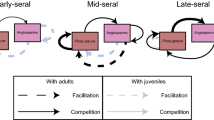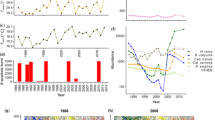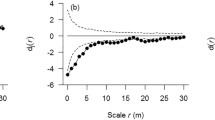Abstract
Linking spatial variation in environmental factors to variation in demographic rates is essential for a mechanistic understanding of the dynamics of populations. However, we still know relatively little about such links, partly because feedbacks via intraspecific density make them difficult to observe in natural populations. We conducted a detailed field study and investigated simultaneous effects of environmental factors and the intraspecific density of individuals on the demography of the herb Lathyrus vernus. In regression models of vital rates we identified effects associated with spring shade on survival and growth, while density was negatively correlated with these vital rates. Density was also negatively correlated with average individual size in the study plots, which is consistent with self-thinning. In addition, average plant sizes were larger than predicted by density in plots that were less shaded by the tree canopy, indicating an environmentally determined carrying capacity. A size-structured integral projection model based on the vital rate regressions revealed that the identified effects of shade and density were strong enough to produce differences in stable population sizes similar to those observed in the field. The results illustrate how the local environment can determine dynamics of populations and that intraspecific density may have to be more carefully considered in studies of plant demography and population viability analyses of threatened species. We conclude that demographic approaches incorporating information about both density and key environmental factors are powerful tools for understanding the processes that interact to determine population dynamics and abundances.



Similar content being viewed by others
References
Alvarez-Buylla ER (1994) Density dependence and patch dynamics in tropical rain forests: matrix models and applications to a tree species. Am Nat 143:155–191
Benton TG, Plaistow SJ, Coulson TN (2006) Complex population dynamics and complex causation: devils, details and demography. Proc R Soc B 273:1173–1181
Brys R, Jacquemyn H, Endels P, de Blust G, Hermy M (2005) Effect of habitat deterioration on population dynamics and extinction risks in a previously common perennial. Conserv Biol 19:1633–1643
Buckley YM, Hinz HL, Matthies D, Rees M (2001) Interactions between density-dependent processes, population dynamics and control of an invasive plant species, Tripleurospermum perforatum (scentless chamomile). Ecol Lett 4:551–558
Casper BB, Schenk HJ, Jackson RB (2003) Defining a plant’s belowground zone of influence. Ecology 84:2313–2321
Colling G, Matthies D (2006) Effects of habitat deterioration on population dynamics and extinction risk of an endangered, long-lived perennial herb (Scorzonera humilis). J Ecol 94:959–972
Crone EE, Menges ES, Ellis MM, Bell T, Bierzychudek P, Ehrlén J, Kaye TN, Knight TM, Lesica P, Morris WF, Oostermeijer G, Quintana-Ascencio PF, Stanley A, Ticktin T, Valverde T, Williams JL (2011) How do plant ecologists use matrix population models? Ecol Lett 14:1–8
Crone EE, Ellis MM, Morris WF, Stanley A, Bell T, Bierzychudek P, Ehrlén J, Kaye TN, Knight TM, Lesica P, Oostermeijer G, Quintana-Ascencio PF, Ticktin T, Valverde T, Williams JL, Doak DF, Ganesan R, McEachern K, Thorpe AS, Menges ES (2013) Ability of matrix models to explain the past and predict the future of plant populations. Conserv Biol 27:968–978
Dahlgren JP (2010) Alternative regression methods are not considered in Murtaugh (2009) or by ecologists in general. Ecol Lett 13:E7–E9
Dahlgren JP, Ehrlén J (2009) Linking environmental variation to population dynamics of a forest herb. J Ecol 97:666–674
Diez JM, Giladi I, Warren R, Pulliam HR (2014) Probabilistic and spatially variable niches inferred from demography. J Ecol. doi:10.1111/1365-2745.12215
Doak DF, Morris WF (2010) Demographic compensation and tipping points in climate-induced range shifts. Nature 467:959–962
Ehrlén J (1995) Demography of the perennial herb Lathyrus vernus. II. Herbivory and population dynamics. J Ecol 83:297–308
Ehrlén J (2002) Assessing the lifetime consequences of plant-animal interactions for the perennial herb Lathyrus vernus (Fabaceae). Perspect Plant Ecol Evol Syst 5:145–163
Ehrlén J, Eriksson O (1996) Seedling recruitment in the perennial herb Lathyrus vernus. Flora 191:377–383
Ehrlén J, Lehtilä K (2002) How perennial are perennial plants? Oikos 98:308–322
Ellner SP, Rees M (2006) Integral projection models for species with complex demography. Am Nat 167:410–428
Fajardo A, McIntire EJB (2011) Under strong niche overlap conspecifics do not compete but help each other to survive: facilitation at the intraspecific level. J Ecol 99:642–650
Fowler NL, Overath RD, Pease CM (2006) Detection of density dependence requires density manipulations and calculation of λ. Ecol 87:655–664
Freckleton RP, Watkinson AR (1998) Predicting the determinants of weed abundance: a model for the population dynamics of Chenopodium album in sugar beet. J Appl Ecol 35:904–920
Freckleton RP, Matos DMS, Bovi MLA, Watkinson AR (2003) Predicting the impacts of harvesting using structured population models: the importance of density-dependence and timing of harvest for a tropical palm tree. J Appl Ecol 40:846–858
Friedman J, Hastie T, Tibshirani R (2010) Regularization paths for generalized linear models via coordinate descent. J Stat Softw 33:1–22
Gelman A, Hill J (2007) Data analysis using regression and multilevel/hierarchical models, 1st edn. Cambridge, New York
Gillman M, Bullock JM, Silvertown J, Clear Hill B (1993) A density-dependent model of Cirsium vulgare population dynamics using field-estimated parameter values. Oecologia 96:282–289
Goldenheim WM, Irving AD, Bertness MD (2008) Switching from negative to positive density-dependence among populations of a cobble beach plant. Oecologia 158:473–483
Gotelli NJ, Ellison AM (2002) Nitrogen deposition and extinction risk in the northern pitcher plant, Sarracenia purpurea. Ecology 83:2758–2765
Guisan A, Thuiller W (2005) Predicting species distribution: offering more than simple habitat models. Ecol Lett 8:993–1009
Harper J (1977) Plant population biology. Academic Press, New York
Horvitz CC, Tuljapurkar S, Pascarella JB (2005) Plant-animal interactions in random environments: habitat stage elasticity, seed predators, and hurricanes. Ecology 86:3312–3322
Hubbell SP, Condit R, Foster RB (1990) Presence and absence of density dependence in a Neotropical tree community. Philos Trans R Soc B 330:269–281
Krebs CJ (2002) Two complementary paradigms for analysing population dynamics. Philos Trans R Soc B 357:1211–1219
Lunn D, Spiegelhalter D, Thomas A, Best N (2009) The BUGS project: evolution, critique, and future directions. Stat Med 28:3049–3067
Luo Z, Mi X, Chen X, Ye Z, Ding B (2012) Density dependence is not very prevalent in a heterogeneous subtropical forest. Oikos 121:1239–1250
Mandle L, Ticktin T (2012) Interactions among fire, grazing, harvest and abiotic conditions shape palm demographic responses to disturbance. J Ecol 100:997–1008
Matos DMS, Freckleton RP, Watkinson AR (1999) The role of density dependence in the population dynamics of a tropical palm. Ecology 80:2635–2650
Maurer BA, Taper ML (2002) Connecting geographical distributions with population processes. Ecol Lett 5:223–231
McMahon S, Diez JM (2007) Scales of association: hierarchical linear models and the measurement of ecological systems. Ecol Lett 10:437–452
Menges ES, Dolan RW (1998) Demographic viability of populations of Silene regia in Midwestern prairies: relationships with fire management, genetic variation, geographic location, population size and isolation. J Ecol 86:63–78
Menges ES, Quintana-Ascencio PF (2004) Population viability with fire in Eryngium cuneifolium: deciphering a decade of demographic data. Ecol Monogr 74:79–99
Murdoch WW (1994) Population regulation in theory and practice. Ecology 75:271–287
Nicolè F, Dahlgren JP, Vivat A, Till-Bouttraud I, Ehrlén J (2011) Interdependent effects of habitat quality and climate on population growth of an endangered plant. J Ecol 99:1211–1218
Peters HA (2003) Neighbour-regulated mortality: the influence of positive and negative density dependence on tree populations in species-rich tropical forests. Ecol Lett 6:757–765
Ramula S, Buckley YM (2009) Multiple life stages with multiple replicated density levels are required to estimate density dependence for plants. Oikos 118:1164–1173
R Core Team (2013) R: a language and environment for statistical computing. R Foundation for Statistical Computing, Vienna. URL. http://www.R-project.org
Salguero-Gómez R, Siewert W, Casper BB, Tielbörger K (2012) A demographic approach to study effects of climate change in desert plants. Philos Trans R Soc B 367:3100–3114
Scanga SE, Leopold DJ (2010) Population vigor of a rare, wetland, understory herb in relation to light and hydrology. J Torrey Bot Soc 137:297–311
Sletvold N, Dahlgren JP, Øien D-I, Moen A, Ehrlén J (2013) Climate warming alters effects of management on population viability of threatened species: results from a 30-year experimental study on a rare orchid. Glob Change Biol 19:2729–2738
Svenning JC (2002) Crown illumination limits the population growth rate of a Neotropical understorey palm (Geonoma macrostachys, Arecaceae). Plant Ecol 159:185–199
Tibshirani R (1996) Regression shrinkage and selection via the lasso. J R Stat Soc B 58:267–288
Tuljapurkar S (1989) An uncertain lifedemography in random environments. Theor Popul Biol 35:227–294
Waser NM, Campbell DR, Price MV, Brody AK (2010) Density-dependent demographic responses of a semelparous plant to natural variation in seed rain. Oikos 119:1929–1935
Yi N, Xu S (2008) Bayesian LASSO for quantitative trait loci mapping. Genetics 179:1045–1055
Yoda K, Hira T, Ogawa H, Hozumi K (1963) Intraspecific competition among higher plants. XI. Self-thinning in over-crowded pure stands under cultivated and natural conditions. J Biol Osaka City Univ 14:107–129
Zeigler SL, Che-Castaldo JP, Neel MC (2013) Actual and potential use of population viability analyses in recovery of plant species listed under the U.S. Endangered Species Act. Conserv Biol 27:1265–1278
Zhu Y, Mi XC, Ren HB, Ma KP (2010) Density dependence is prevalent in a heterogeneous subtropical forest. Oikos 119:109–119
Acknowledgments
We are grateful to Mia Bengtsson, Samira Englund, Ade González Menéndez, Jessica Honkakangas, Liv Jonare, Tove Lund Jörgensen, Camilla Niklasson, Anna Palmé, Suzanne Rosengren, Karin Skagerlund, Ana Sola and John Swensson for help with the data collection and to two anonymous reviewers of the manuscript. We acknowledge funding from the Swedish Research Council (to J. E.). J. P. D. was partly funded by the Strategic Research Programme EkoKlim at Stockholm University and by the Max Planck Society. The study complies with the current laws of the country (Sweden), in which it was performed.
Author information
Authors and Affiliations
Corresponding author
Additional information
Communicated by Truman Young.
Electronic supplementary material
Below is the link to the electronic supplementary material.
Rights and permissions
About this article
Cite this article
Dahlgren, J.P., Östergård, H. & Ehrlén, J. Local environment and density-dependent feedbacks determine population growth in a forest herb. Oecologia 176, 1023–1032 (2014). https://doi.org/10.1007/s00442-014-3073-9
Received:
Accepted:
Published:
Issue Date:
DOI: https://doi.org/10.1007/s00442-014-3073-9




